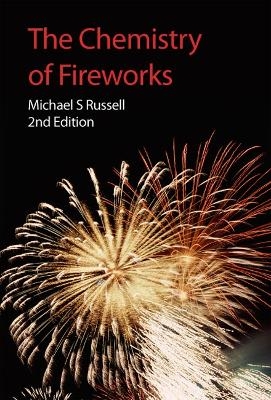
Chemistry of Fireworks
Seiten
2008
|
2nd edition
Royal Society of Chemistry (Verlag)
978-0-85404-127-5 (ISBN)
Royal Society of Chemistry (Verlag)
978-0-85404-127-5 (ISBN)
"Aimed A level students, this book discusses the theory of fireworks in terms of well-known scientific concepts wherever possible, in a concise and easy to understand style."
"For centuries fireworks have been a source of delight and amazement in cultures around the world. But what produces their dazzling array of effects? This book takes you behind the scenes to explore the chemistry and physics behind the art of pyrotechnics. Topics covered include history and characteristics of gunpowder; principles behind each of the most popular firework types: rockets, shells, fountains, sparklers, bangers, roman candles and wheels; special effects, including sound effects, coloured smokes and electrical firing; firework safety for private use and displays; and firework legislation. The Chemistry of Fireworks is aimed at students with A level qualifications or equivalent. The style is concise and easy to understand, and the theory of fireworks is discussed in terms of well-known scientific concepts wherever possible. It will also be a useful source of reference for anyone studying pyrotechnics as applied to fireworks. Review Extracts ""a worthwhile addition to the pyrotechnist's library"" Fireworks ""a useful source of information which makes absorbing reading."" Angewandte Chemie, International Edition"
"For centuries fireworks have been a source of delight and amazement in cultures around the world. But what produces their dazzling array of effects? This book takes you behind the scenes to explore the chemistry and physics behind the art of pyrotechnics. Topics covered include history and characteristics of gunpowder; principles behind each of the most popular firework types: rockets, shells, fountains, sparklers, bangers, roman candles and wheels; special effects, including sound effects, coloured smokes and electrical firing; firework safety for private use and displays; and firework legislation. The Chemistry of Fireworks is aimed at students with A level qualifications or equivalent. The style is concise and easy to understand, and the theory of fireworks is discussed in terms of well-known scientific concepts wherever possible. It will also be a useful source of reference for anyone studying pyrotechnics as applied to fireworks. Review Extracts ""a worthwhile addition to the pyrotechnist's library"" Fireworks ""a useful source of information which makes absorbing reading."" Angewandte Chemie, International Edition"
Michael S Russell is a Chartered Chemist and a member of the RSC. His experience lies in the design of pyrotechnic devices mainly for fire or explosion suppression or military applications. He acts as a Consultant for explosives safety and safety training courses. He has also developed pyrotechnics, smokes, flares, rockets and gas generators.
Historical Introduction;
The Characteristics of Black Powder;
Rockets;
Mines and Shells;
Fountains;
Sparklers;
Bangers;
Roman Candles;
Gerbs and Wheels;
Special Effects;
Fireworks Safety;
Fireworks Legislation;
Subject Index.
| Erscheint lt. Verlag | 13.11.2008 |
|---|---|
| Verlagsort | Cambridge |
| Sprache | englisch |
| Maße | 152 x 228 mm |
| Gewicht | 586 g |
| Themenwelt | Sachbuch/Ratgeber ► Natur / Technik |
| Naturwissenschaften ► Chemie ► Anorganische Chemie | |
| Naturwissenschaften ► Chemie ► Physikalische Chemie | |
| Technik ► Umwelttechnik / Biotechnologie | |
| ISBN-10 | 0-85404-127-3 / 0854041273 |
| ISBN-13 | 978-0-85404-127-5 / 9780854041275 |
| Zustand | Neuware |
| Haben Sie eine Frage zum Produkt? |
Mehr entdecken
aus dem Bereich
aus dem Bereich


